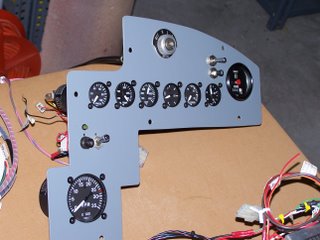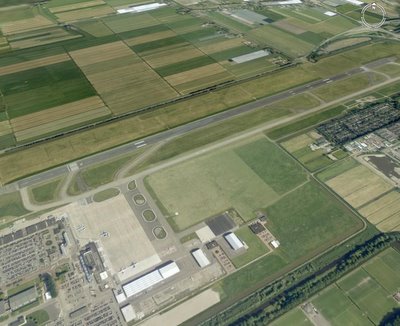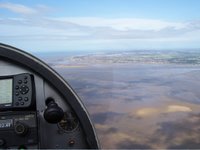Monday, December 11, 2006
Bolkow Newsletter - December 2006
Since this is a December newsletter may I wish you all a Happy Christmas! Let’s hope our Christmas stockings will contain something aviation minded such as a Coloured GPS, a glass cockpit kit etc! Anyway, I hope you get what you want.
May your New Year be safe and accident free and as Gunther says “always a turning prop!”
Welcome to Mark Kaye who has joined the group owning Bolkow 208c (No.204) G-ATXZ. If I remember correctly this aircraft is kept at Tatenhill. Tatenhill is well worth a visit – great airfield and extremely pleasant staff. Mark is a professional photographer who has offered his services to the club, free of charge. Thankyou Mark!
Thankyou and welcome to Tim and Nick Ravine, also Elizabeth who e-mailed me. They are now the proud owners of Bolkow 208c G-ATSI.
G-ATSI is on a 2 year EASA certificate and Tim and Nick would appreciate some info on friendly engineers to either work on or sign for work done. Can someone help please? The aircraft is now kept at Sywell after being hangared at Shipdam in Norfolk for over 30 years. Contact can be made on Tel. No: 01604 720023 or 01604 770191. They suggest that Sywell would be a suitable venue for a fly-in. I agree. Lets hope we get some suitable weather.
Colin Hampson, Dereks’s son, is using his talent to produce a web page www.bolkowsquadron.blogspot.com. Here we can post details of meetings, fly-ins, photographs, trip reports, wanted adds, information etc and anything else to do with Bolkows. The site already has some interesting articles and photographs of members aircraft. Contact Colin through colihamp@gmail.com.
Stewart Buckingham now owns Bolkow 208c D-EEAH (lucky man. It’s a very nice aeroplane!) and keeps it at Boscome down. He has certainly put it to good use since he got it having flown it around the Isle of Man and Ireland and then joined two dozen other aircraft and flew it in the “Around Ireland Air Rally”. That was in 2005. This year he teamed up with 13 aircraft and entered the “Around France Air Rally”. Trips to Germany for its annual Cof A and a weekend in Calais demonstrated that he is an intrepid aviator with a very capable aircraft. In 2007 he is joining the “Around Germany Air Rally” and taking D-EEAH back to Laupheim on the 40th anniversary of her first flight in 1967. Phew! I think we should watch this space!
Stewarts friend who accompanied him in the Ireland rally was obviously impressed with the Bolkow’s performance that he is now scanning the adverts in case one comes onto the market.
Nigel Everett sent me the following e-mail regarding Bolkow Junior
G-ATSX.
“I am one of four group owners of G-ATSX. When we bought her about two years ago she had a C of A and was in working order. However, in a regrettable fit of zeal, we decided to strip her down and rebuild her. We disassembled her and stripped the paint, finding the bodywork largely free of corrosion. We were then held up, partly by the need of someone to repair the damaged trim tab and partly by running out of steam. With the superb help of wonderful Gunther I managed to arrange for him to get the trim tab fixed in Germany and we now have it back, complete with paperwork. This winter, either I shall get the chaps to work and finish the project ( might need a large whip Nigel! Ed) or next summer we shall have a complete box of bits for sale (shame! Ed))
There were five of us in the group originally, but one has already died. I did suggest a Tontine arrangement, whereby title to the Bolkow (complete or box of bits? Ed) would pass entirely to whoever outlived the rest, but they did not take to that. I think that we may have to pass a rule that no one else may die until the project is complete.”
As editor of the newsletter I am in the process of compiling a members list which I hope will include telephone numbers and e-mail addresses. This to enable any Bolkow group member to get directly in touch with any other group member. As soon as it is completed I will e-mail you all. If I find I don’t have your details I will contact you. If you don’t want your details put into the list, please let me know. (philipswain@talktalk.net)
A contact list is always useful if you want any hints or advice from other members.
Sad about the PFA Rally. It was a good opportunity to meet up as we have done in previous years. We’ll have to arrange our own BOLKOW RALLY
The Bolkow Club is open to all aviators who own Bolkow aeroplanes i.e. 207’s, 208’s and 209’s etc
Saturday, November 04, 2006
Warbird! - N905BB
 My work follows the history of these ships that has been published, as well as by one of the pilots of the era. Further, my neighbor was a relief pilot at that time, flying KC96s and DC7s into Biafra with food and flying out with wartime orphan children. Biafran history has been fascinating for me, considering that the country existed only 3 years.
My work follows the history of these ships that has been published, as well as by one of the pilots of the era. Further, my neighbor was a relief pilot at that time, flying KC96s and DC7s into Biafra with food and flying out with wartime orphan children. Biafran history has been fascinating for me, considering that the country existed only 3 years.
 The conversion is not merely a transplant, and has required some engineering solutions. The 125 hp should be ideal. I had studied the 3300 Jabiru, which would have been a better choice actually, but they were not delivering at the time and I had to make my decision.
The conversion is not merely a transplant, and has required some engineering solutions. The 125 hp should be ideal. I had studied the 3300 Jabiru, which would have been a better choice actually, but they were not delivering at the time and I had to make my decision.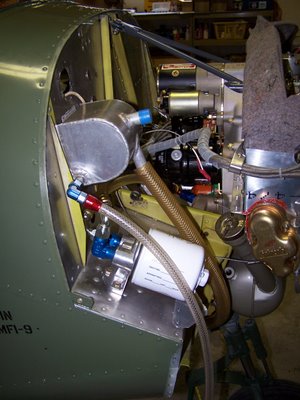
Friday, November 03, 2006
To really love an aeroplane...
To really love an aeroplane
To understand her - you gotta know her deep inside
I inherited my aeroplane CJE (Emma) in 2000 from my father. In 2005 with more and more niggling problems occurring (age 41 years to be expected) I decided it was time to have a good look under her cowlings. I was in the perfect location. I was surrounded by helpful aircraft engineers. To my horror they handed me a set of overalls and told me I needn’t think I was getting off that easy. Over the course of a year (I had to save for some things and fit it in-between a new full time job) my engineer and I isolated problems and solved them. I was introduced to paperwork things, like Airworthiness directives, engine, propeller and airframe log books. I spent a couple of days with my engineer doing the annual check and compass swing. I got grease under my fingernails and discovered handy tools I’d never dreamed of. I was educated.
Hear every creak - see every crack
N' give her wings when she wants to fly
I have a new respect for engineers. A good engineer, one with years of experience a) knows where to look for problems and b) can see what I can’t. As I said there is no replacing experience. Having been involved in the process, having seen her naked, so to speak, I am much happier flying her. I have a handle on how she is put together and what is important. My pre-flight checks are now not a cursory walk around; I truly pay attention to details. I know what all the bits are for.
Then when you find yourself paying endlessly for her bills
Ya know ya really love an aeroplane
At times my mother despairs at my expenditure and suggests I sell her. Then she sees it’s a hopeless case and buys a temporary share of some part. A fuel line or two, an exhaust manifold, a transistor or two in a VHF radio. I am just wondering if she’d like an ELT antenna for Christmas.
When you love an aeroplane you tell her that she's really wanted
When you love an aeroplane you tell her that she's the one
Earlier this year a friend of mine came down to do some night flying in Christchurch (Kaikoura doesn’t have lights) after spending some time with her I realised how much I missed flying. I starting flying FSL, the Air New Zealand flying club 152 and much as I liked her she just isn’t the same. Emma is like no other. Well similar to 9 others.
Cuz she needs somebody to tell her that she's gonna last forever
So tell me have you ever really - really really ever loved an aeroplane?
The blood sweat and tears, the time, the frustrations, the angst every cent is repayed when I know I am improving her restoring her so she will continue to support me in the air. I am very keen on reliability whilst Crossing the Cook Strait or flying up the Kaikoura coast.
To really love an aeroplane
Let her hold you - til ya know how she needs to be touched
Emma has pushed me further than I would have gone by myself. Because I inherited her I took up learning to fly again. (I had 24 hours in Tomahawks). I needed to earn more money so I had to change my career path to afford her. I wanted to go to fly-aways with her so I had to get brave and extend myself. Now I’ve started to understand the engineering side I am inspired to learn more and so I’ve started studying for my Aircraft Maintenance Engineering exams. I just need to learn how to let her ride the NW and rise above the Kaikoura rollers.
You've gotta breathe her - really taste her
Til you can feel her in your blood
That’s easy with a Bolkow she is so small it’s like strapping on an aeroplane. In a strange way she is like a costume because when I fly her I am a different person. You can’t be half hearted about flying or landing her. She doesn’t forgive a lack of attention.
N' when you can see your future destinations in her eyes
Ya know ya really love an aeroplane
Now that she is back in the air I can’t wait to go visiting. The effort that I’ve put into getting back in the air I am damned if I am going let a chance go by to fly her.
You got to give her some faith - hold her tight
A little tenderness - gotta treat her right
She will be there for you, takin' good care of you
Ya really gotta love your aeroplane...
(Adapted from Have you really ever loved a woman by Bryan Adams.)
In The Family Way...
In the beginning there is the desire. Some of us desire petite and graceful girls (Europa), some of us desire a good hard working girls (185s) and some of us desire unique and unusual girls with attitude (Murphy rebels). Some people even share their girls (ménages a trois). Budget and genetics are usually what decides the outcome of the hunt. Some people will search the world for what their hearts desire and some people will settle for the girl next hangar/door (DDK). Whatever the chase is always the most exhilarating time and when we will blindly spend money without a care.
Then there comes the conception. Always fun, sometimes a surprise. Happens everywhere but usually in the cover of dark, close to a pub and again with unrealised amounts of money being committed to. Sometimes it is difficult to tell the partner of the reality of the situation. I have heard of a man agonising for three weeks on how to tell his wife about what he has done, only to find she wants a piece of the action.
Gestation is a long period of discovery. The early days can involve a bit of throwing up until the body gets used to the different environment. Partners may argue usually over large cockpit plus sized pieces of coloured paper. There can sometimes be strange cravings that people will travel large distances to satisfied. Karamea for Whitebait, Invercargill for oysters, Dunedin for Emersons. This is a time of discovery, a time of expanding of ones knowledge and diplomatic skills.
The birth a challenging time. The coming into the real world. The passing through very narrow gaps with a lot of screaming and swearing. Some partners choose to close their eyes or faint at this point. Dingle is a classic place of being born. An airstrip that needs a lot of respect and a midwife to glide the way. Dingle is Pristine, stunningly beautiful and not a place you’d go unless you’ve done your time (gestation), not for the inexperienced. There is always the option of having Julius fly you in, straight in by fling wing. (Caesarean). Afterwards you can stay for a bit and relax. ($15 and a sleeping bag).
Now reality hits, the sleepless nights, the worrying if you’re doing it right and just in case you thought you were your mother-in-law/CFI will set you straight. The bringing up years seem to last forever as do the bills. If you’re not very careful you can find yourself repeating the exercise from the start and you will need a bigger hangar. A few of our members must enjoy this first phase because they seem to be very good at it and buying ever bigger aeroplanes.
About this time the socialising happens. Mothers will form support networks and the children all get to go to play group. (fly-ins). At these gatherings there is a lot of chatter, eating and drinking. The girls will play dress up and the boys will go back to there roots and climb trees, though these lines of demarcation are less defined now days. Basically it is about showing off. Sometimes there are accidents, heads need to be bandaged and tears wiped away before bedtime.
As children get older they venture further a field. They play in other peoples sandpits and learn to share their toys. It can be fascinating and a source of intense jealously when children find out what their friends have in their toybox. Tantrums are common when sharing doesn’t occur or the child demands to have the same toys. Kokonga is such a toybox. Peace can be maintained with bribery. Usually lollies are a good distraction and I have to congratulate David for his circumvention of a potential ugly situation with a large bag of the sponsors lollies. I was also pleased to see everybody sharing their toys in the form of sharing rides. I was elated to get to play in DIH again, Thank-you Tom you are a good boy.
When children get into their teenage years they have a very select group of friends usually not of their parents choosing. This is when they have to be watched closely but from a distance. Teenagers know everything so there is no use trying to teach them anything more. You can but sit back and hope you have taught them enough sense not to kill themselves or go down the family way path too soon. Food and drink looms large in their horizon and they can often be influenced in this way. Too much drink can create mischief and modified behaviour. It was observed that a certain 185 toy was transformed. Luckily nobody was hurt in the process.
Eventually they come of age, they mature. Don’t think you are scot-free though. They are still around for dinner or a loan. Loans now of course being huge in relation to their desires. A girlfriend to impress, a car, a career as a commercial pilot or if you’re really unlucky to buy an aeroplane. Hence the next generation of aviators are born, the cycle repeats. You’ll know if you have brought them up properly because they’ll have manners enough to invite you to go flying with them when you get too old (50) and nasty people take your licence off you for knowing too much.
Thanks team I thoroughly enjoyed the play group at Omarama this year. The Saturday fly around as always taught me new ways of doing what I thought I already knew and the way you share your toys does credit to your upbringing. Those of you who are concerned about the theme of this piece needn’t start knitting me booties, one precocious Bolkow is more than enough for me to handle and afford.
PS: Alistair I’d like to remind you of the agreement we made in the bar. I’ll let you come and play with mine if you let me play with yours. Besides it’s in your best interests because I am younger than you and you’re in danger of knowing too much.
Wednesday, October 11, 2006
'Flying For Fun' 2006
The first weekend in July arrived, and Mother Nature revealed a rather warped sense of humour. You might remember 1st - 2nd marking the beginning of what turned out to be the hottest July on record. The British Grand Prix had even been moved. I turned to one of the Twenty-First Century's greatest minds to sum it up best...''Doh!''
''Fear not'' the BBC told us. ''If you thought July was hot, just wait until we get to August.'' Well, August arrived, and I was less than impressed. Wet and windy conditions prevailed over the first two weeks, and I began to fear the worst. Fast-forward to the Wednesday before the Rally, and I dispatched a 5 day weather forecast to fellow Bolkow flyers, Gunther Butterweck, Stewart Luck, and my father, Derek. The forecast looked alright, certainly better than I had first thought. Stewart e-mailed back, ''Well, your forecast is better than mine!''
By the time dawn made an appearance on the Saturday morning, I had digested the various weather reports (along with my breakfast), and was confident that it was a 'go'. Hampson Snr called from Rotterdam for an update. The plan for my father to fly across from Rotterdam and pick me up from Goodwood. From there, we would fly direct to Kemble. ''It's o.k here, I'm going to set off in 30 minutes''.
Driving to Goodwood, the weather was bright and breezy. Cloud was building from the south-west, but it was suitably dispersed and the visibility looked good. So, there was nothing for it but to wait for my father to arrive in G-ME. I was expecting him at 10:15hrs (L), which came, and went. Just before the point of getting concerned, the Bolkow appeared overhead at 10:45hrs (L).
''Battery was flat.'' was the response to my mild look of concern (or maybe that was just the wind-swept effect?) as the intrepid aviator, complete with a striking yellow lifejacket, deplaned at the fuel pumps. ''Ah''.
Fuel and landing fees paid, we jumped into the Bolkow for the next sector. Dad kindly relinquished the left-hand seat, and I handed over my PLOG and deputised him in the role of 'Navigator'. We briefed for a 24 departure which involved an early right turn for noise abatement, and also for the anticipated procedure into Kemble. As we started up a pair of French homebuilts were getting airborne, also bound for the Rally. The route would take us north-west to Popham, turning slightly to a more north-north-westerly track towards Swindon. From here we would pick up the mandatory VFR route inbound to Kemble.

Passing Swindon, picking up the VRPs that make up the VFR route proved to be straight-forward. One 'gotcha' when flying into the Rally is that there are two water towers, and care must be taken to identify the correct tower (Malmesbury) before turning towards the field. Approaching Malmesbury water tower, we had a Bulldog behind us we began our decent and turn towards Oaksey Park. The Bulldog had seen us and slotted behind in trail. The ATIS had given Runway 26 as active, and on changing to 'Kemble Hard' the frequency was typically busy with finals calls. Flying the specified offset approach (to avoid Kemble village), we rolled wings level on short final, touching down nicely (''taildragger style'', my 'navigator' commented) and vacated at the first exit.

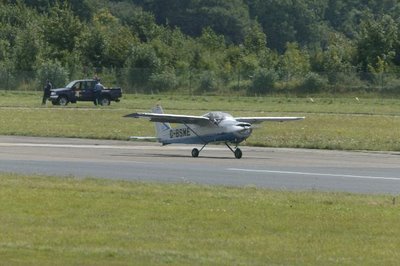
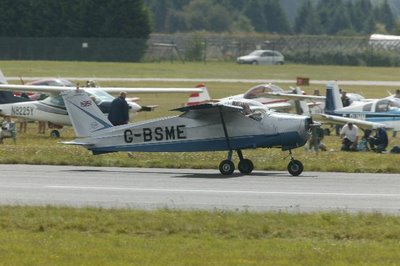
(G-ME arriving at Kemble)
After parking up and booking in, we set off to find our fellow Bolkow Squadron members. We had seen D-EHAC in the aircraft park so knew Gunther had made it. We found Gunther Butterweck and Stewart Luck at the PFA Education tent. Stewart has been responsible for the fantastic 'Build-a-Plane' project and he was kept busy all weekend flying people in 'The Spirit of Brooklands' (G-TSOB). We also met Mark Kaye (G-ATXZ) who drove down from Tatenhill with his girlfriend (I'm terrible with names), and enjoyed a few beers in the Education Strut's motor home. Clive Morris managed to fly G-AVKR in from Deanland. Clive was the only other Bolkow I saw (any others?) in the aircraft park.


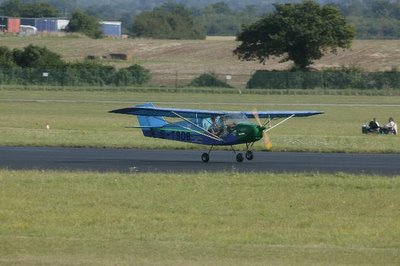
(Stewart Luck bringing 'The Spirit of Brooklands' back down to Earth)
That night, we stood outside the 'Beer Tent' in the drizzle and the dark, and joked about why we go to great lengths, year after year, to get to Kemble, to stand on a wet, cold airfield, drinking warm beer. ''Same again next year'' was the unanimous response.

(Derek Hampson, Colin Hampson, Gunther Butterweck, Stewart Luck)
With G-ME having to get back to Rotterdam, and D-AC to Bonn Hangelar, we left at lunchtime on the Sunday. There was enough moisture in the air to neccesitate 'weather avoidance' on the return home, but in general the conditions were o.k. A brisk westerly wind gave reports of 126kts groundspeed for G-ME as it skirted up the Belgian coast. Gunther later told us that he saw 133kts on the GPS whilst over France. This must be a record, Gunther?
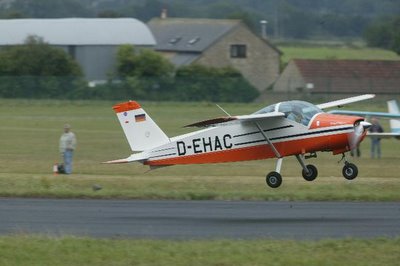
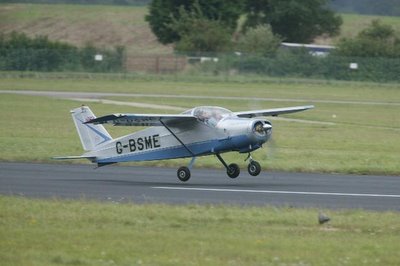
(D-AC and G-ME depart Kemble. Same again next year?)
So, another year of 'less than ideal' weather meant that the PFA, despite their best efforts, have almost certainly made a significant loss (again). The actual weather conditions at Kemble were, in general, quite reasonable. However, many people will have been put off by the forecast, and physically getting to Kemble from certain places was likely more trouble than it was worth. Those of us who did make it certainly enjoyed meeting up, walking around the aircraft park and watching the aeroplanes arrive and depart. Some 600 aeroplanes made it to Kemble this year, if there is another Rally, we will be back in 2007.
Monday, October 09, 2006
The Around Ireland Rally - Trip report

Maps and Irish Pooleys were purchased, club life vests and dinghy were serviced, and for good measure emergency locator beacons were bought. The route included 3 water crossings of up to 40 miles each so prudent precautions were in order. The rally plan was for the ~25 participating aircraft to assemble at Haverfordwest by mid-day on Thursday 21st June, to depart to Weston (near Dublin) then to work round the coastline clockwise to Waterford (SE), Kerry (SW). Galway (W), Sligo, Enniskillen, Donegal (NW), Londonderry (Eglinton) and Aldergrove (NE), then across to Ronaldsway in the Isle of Man for a end-of-rally celebration on Monday 25th, and back home on the 26th, some 14 flying hours and 1400 miles later. But as we all know, plans and reality do not always coincide!
Carl and Kaleb reached Haverfordwest on the evening of the 20th and met up with Gilly and several other participants who likewise thought it best to get to the assembly point the night before the mass departure. But for Tony and I the lead-up to the rally had become fraught because I needed to get the German C of A renewed on D-EEAH before setting out and a snag with the engine delayed the trip I had to make to Germany for the renewal. Eventually I arrived back from Germany on the evening of Wednesday 20th and Tony and I decided to slip our departure for Ireland back to early on Friday 22nd. By skipping the Weston stopover we planned to intercept the rest of the crews at Waterford. Good plan, we thought! And as Carl and Kaleb has decided also to forego the Weston stopover and route direct to Waterford to avoid what looked on paper a rather complex procedural routing into Weston, Tony and I looked forward to meeting ROBN at Waterford. So D‘AH was all loaded and ready to depart Boscombe early on the Friday morning. Or so we thought. The ASI thought otherwise. We were clearly accelerating nicely down 23 but the ASI insisted on believing we were stationary. Take-off aborted, taxy back to the club. It was Tony’s first flight in D’AH – not an auspicious start! Lesson 1 – if you can see that you are clearly doing 30+ kt and the ASI says zero, don’t wait and hope it will recover, abort! ASI failures CAN and DO happen – even to me or you! On 23 I had lots of space to abort from perhaps 50 kt but on some airfields I may by then have been committed to getting airborne with no ASI! Fortunately for us, Brian Carter was there helping Neil Grayson prepare D-KIMM for his C of A renewal trip to Germany and with his kind assistance remains of several flies were removed from the pitot line and an hour or more later than planned we were on our way.
A fuelling stop at Haverfordwest and we were off again to Waterford. The sea crossing was uneventful except that the overcast kept us little above 1000ft much of the way, which would have left little time to deal with any emergency. London Information asked us to relay a message to a Czech aircraft which was apparently crossing at 600 ft and was clearly below their radio horizon. But below the overcast the visibility was OK, and as we approached the Irish coast the overcast lifted and the Waterford weather was bright and clear as forecast.

 Tramore, consumed Guinness and speculated about just how much of the water of the North Atlantic would be precipitated down onto us. When an improvement to the weather started to be forecast we considered abandoning the rally and returning home, and one of the four aircraft eventually did just that. But by the Sunday afternoon the weather had cleared at Weston and further north so the aircraft from Weston made a break to Sligo and on to Donegal in the north west by the evening – which got them back on the planned schedule, so they then flew the Monday route to Eglinton, Aldergrove and Ronaldsway as planned.
Tramore, consumed Guinness and speculated about just how much of the water of the North Atlantic would be precipitated down onto us. When an improvement to the weather started to be forecast we considered abandoning the rally and returning home, and one of the four aircraft eventually did just that. But by the Sunday afternoon the weather had cleared at Weston and further north so the aircraft from Weston made a break to Sligo and on to Donegal in the north west by the evening – which got them back on the planned schedule, so they then flew the Monday route to Eglinton, Aldergrove and Ronaldsway as planned.A very sociable evening followed, with much exchanging of stories of the flying and a very heart-felt vote of thanks to Bob Manners and Dick his assistant for all their work planning and arranging the rally. And, of course, another round of discussion about “what can we do next year?” The preference seemed to be for a tour of France – in the hope that the weather would be better!


Saturday, October 07, 2006
International Old Timer Fly-in 2005 - Trip report
The sun was just making an appearance as I left the house for the 90 minute drive to the airstrip where my (then) Bolkow Junior D-EDNA was based. The forecast was pretty good, so spirits were high as I negotiated my way around the (unusually clear) M25 and down the M3 towards Winchester. Arriving at the airstrip at 07:00hrs (L) I loaded my bag into the aeroplane and began to make preparation for my departure. I was on my own for the trip. My (then) fiancee, a firmly earth-bound soul, refused to come; and my housemate (usually up for most things) failed to secure a weekend pass from 'the boss'. Poor show.
Diest is approximately 250nm from my (then) home strip of Farley Farm in Hampshire, so within range for a direct flight. However, with no fuel at the strip, and with about half tanks, I needed to stop for fuel before I ventured across the Channel. The day before I happened upon the website for 'London Ashford Airport'. That's Lydd to you and I. They were offering tax/duty free Avgas for all international departures. London Ashford Airport is, of course, nowhere near London, but located on a headland directly on my intended route of flight. Ideal! Lydd opened at 09:00hrs (L), so I planned to arrive overhead at 08:55hrs (L).
Farley Farm has a single 800m runway (06/24). Huge trees placed strategically on the western threshold effectively reduce the distance available to around 650m when using 24. Bags of room for the Bolkow with one up, half tanks and an overnight bag. The strip sits right on the edge of the Solent CTA so once airborne it's advisable to contact Solent Radar for a FIS. This is especially important when leaving the area to the East as you cross the extended centreline of the active runway at range 8.5nm.
Clearing the area to the East, I tracked towards Petersfield, where the South Downs become very conspicuous. Running West/East, the Downs make an ideal 'follow me' sign for a good 30nm. The visability was good, with early morning mist and dew sitting in the low lying shadows of the hills - all very spectacular. So often overlooked, the scenery in this part of the country really is fantastic. Flying in the early hours brings many rewards; Such hours are exempt from the often turbulent and convective nature characteristic of an August day. It has fast become my favourite time to fly.
Leaving Solent behind, London Information became my companion for this first part of the trip. The headland at Seaford provided a constant reference as I parallelled the coast eastward. Passing Rye at around 08:50hrs (L) I gave Lydd a call, half expecting to hold in the area for 10 minutes or so. To my pleasant suprise, Lydd responded with joining instructions, and I gratefully accepted the invitation to proceed into the overhead. Upon reaching, I was advised to continue my descent for a ''tight right-hand circuit for 03'' and expect a late clearance. The fire truck was still doing its runway inspection, but would (should?) be clear. The circuit at Lydd can be quite tight due to the proximity of the Dungeness power station to the South of the field. Various Danger Areas also litter the headland, so it pays to plan your circuit carefully.
The requirement for a ''tight'' circuit meant that it was an ideal candidate for a glide approach. Speed back, flaps to 17° for the glide. 600ft at the 'Low Key' position abeam the numbers, checks complete (where's that clearance?) I turned in on the glide adopting the 'constant aspect' technique. ''Delta November Alpha, cleared to land Runway 03, wind light and variable'' is broadcast through my headset as I roll wings level 200ft on 'short' final. Flashing over the numbers, the Bolkow settled nicely onto the new tarmac after a short but satisfying float. 'I enjoyed that', I thought as I taxied to the parking area by the fire house. ''Delta November Alpha, welcome to Lydd, landing time zero one''.
After just 20 minutes, the aeroplane was refuelled, landing fees paid and I was back in the saddle starting up for the next sector. The service at Lydd was exemplorary, and at 77p a litre and a £10 landing fee, I taxied out with a huge grin.
Departing towards the sea, I was 'feet wet' just one minute after take-off. I decided to stay with Lydd for the crossing, and gave Calais a call mid-Channel. The weather was still good. Visability was in excess of 10km giving a workable horizon for the crossing. As many will know, local conditions can sometimes conspire against pilots making this crossing. The brightness of the morning sun can generate a fair amount of haze, and can 'smudge' the horizon when it's needed most. ''Bonjour Calais...'' in my most stereotypical 'Englishman speaking French' manner marked the FIR boundary. Advice and past experience told me it would be pointless calling Lille Approach, as they seldom take interest in small GA traffic. Calais Tower is often the better bet - and so it proved to be.

It was upon crossing the French coast that the visability began to deteriorate. It was still very bright, but there was a good amount of broken cloud at around 2500ft and it was certainly much more hazy. The entire sky was the characteristic milky irrediscence common to summer days. Perfectly flyable, but it certainly would increased the workload across this part of Northern France. Those familiar with this part of France will know that it is pretty featureless until you cross into Belgium and reach the urban areas of Ghent and Antwerp. D-NA had no GPS fitted at the time, so all navigation was done by map-reading and dead reackoning by compass and stop-watch.
I was passed onto Ostend for a FIS. Tiny villages passed underneath my wing as I made steady progress East. I could just about make out the town of Ypres, (in)famous for the bloddy battles of the Great War. Now, a place of pilgrimage, the area around Ypres is saturated with the graves of soldiers who fell during the Battle of the Somme.
It was only upon reaching the confluences of Ghent that my faith in my navigation was affirmed. From here onwards, the navigation element would become easier. There did remain, however, one final hurdle to overcome. In order to reach Diest, one must route accurately between the Antwerp and Brussels control zones. A narrow corridor approximately 2nm wide is all that prevents an unpopular 'zone bust'.
After safely negotiating the corridor, I began to make preparations for my arrival into Diest. As with any event of this nature (such as the PFA Rally), traffic can be very heavy, and proper planning is essential to ensure a safe and efficient arrival into the event. Procedure dictated that pilots obtained the ATIS as soon as possible before reaching the field. Unlike the PFA Rally, where there are mandatory arrival routes and procedures, Diest employs a fairly standard downwind join. This is the point where I wished I had another set of eyes in the cockpit as the workload increased dramatically.
The ATIS was giving Runway 26 as active, so I proceded to join downwind, keeping a good lookout for other traffic. There were aeroplanes everywhere! 'This is going to be interesting', I thought to myself as I completed my downwind checks. Turning base, number five to land. Speed back and settling in the approach configuration, frantically moving my head (bird like I'm sure) trying to acquire all the aircraft. A Harvard was circling on a long final, waiting for a gap to appear - he would slip in behind me. On final approach, still one ahead just completing its landing roll. Short final and the runway becomes clear, the Bolkow comes over the hedge and kisses the grass gracefully. I make sure to vacate as soon as is safe to do so and make my way over to a gentleman waving ping-pong bats at me.
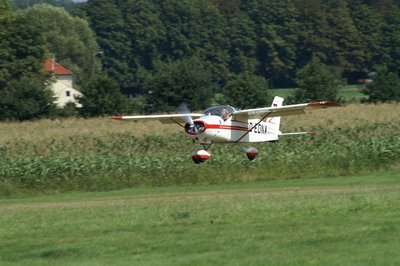


(Gunther Butterweck arrives in D-EHAC)
'I'm here, and what a great flight it was'. I was immediately greeted by the rest of the Bolkow contingent, Gunther Butterweck and my father Derek. Hampson Snr had arrived in G-BSME from Rotterdam the night before and Gunther had flown D-EHAC from Bonn Hangelar earlier that morning. The people at Diest do a great job of looking after their guests and after booking in and closing the flight plan, we tucked into the long-standing, traditional Belgian dish...Frites et Mayonaisse!
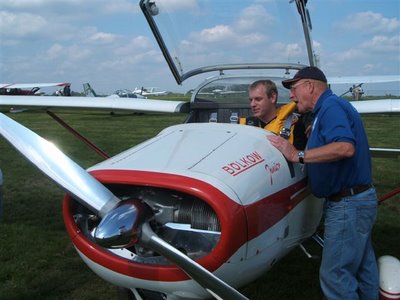
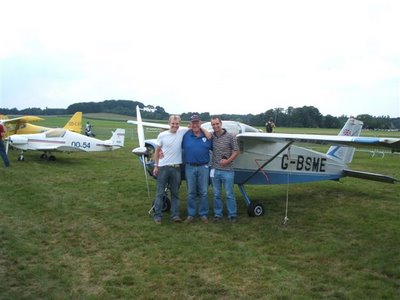
(The Bolkow contingent - Colin Hampson, Gunther Butterweck & Derek Hampson)
We spent a good few hours looking around the aircraft park admiring the various vintage types that had made the trip. D-NA was due to have it's annual in the weeks following the fly-in and would have to go to Germany. Therefore, the plan was for my father and I to fly back to Rotterdam and swap aeroplanes there. I would take G-ME back to Blighty and my father would take care of the annual - thanks Dad!
Gunther departed at the same time, so spectators were treated to three Bolkows taxying out and departing in sequence. It was a short sector of some 80nm, and we would fly it in formation until we reached controlled airspace where I would drop back and we would arrive seperately.
As my father was rolling, I lined up behind and began to roll as G-ME got airborne. D-NA has a climb prop fitted so accelaration was good and I soon caught up with Hampson Snr in G-ME. We set up 90kt cruise settings (G-ME approx 2300-2350rpm, D-NA approx 2400rpm) and tracked North. We passed East abeam Seppe, and approaching ROMEO I pealled away and dropped back out of formation.


Rotterdam publishes mandatory VFR routes both inbound and outbound to the field. ROMEO is a large railway yard on the southern edge of the city. The inbound route follows a motorway up to a large junction to the south-east of the airport. From here, aircraft proceed to a position south abeam the field and turn to cross overhead, breaking downwind (either left or right) for the final descent. I saw G-ME cross the numbers as I broke into the downwind leg for Runway 06. As with most large airports blessed with huge runways, it's prudent to plan where you're going to land in order to make a particular turn-off, otherwise a prolonged taxi-in can be expected. Intersection V3 is approximately 350m in from the threshold, and is the preferred turn-off if you can make it! If not, it's best to land long as its a fair way down to V2!

(D-NA and G-ME back at Rotterdam Airport)
So, farm strip to regional airport to military field to international airport made for plenty of variety. Make The 2007 International Old Timer Fly-in the first thing you put on your calender in the New Year.

Thursday, October 05, 2006
The Fleet
Owned by Capt. Stewart Luck, 'TR' is a lovely red and white 1966 Bolkow 208C Junior. Also flown by Stewart's son, Henry, 'TR' is a frequent visitor on the U.K fly-in scene. Stewart is a Captain on the B747 'classic' fleet and runs the PFA's Youth & Education Strut (YES) and 'Build-a-Plane' project (www.flyers.org.uk).
 G-BSME
G-BSMEOwned by Derek Hampson since 1990 and currently based in Rotterdam, The Netherlands. 'ME' was built in 1966 and sports (for now) a fairly non-standard silver and blue scheme. Derek is an engineer with Shell Aircraft looking after their fleet of business jets. 'ME' usually makes it to most Bolkow gatherings in the hands of Derek, or occasionally myself!
 D-EHAC
D-EHACOwned by 'Mr Bolkow' himself, Herr Gunther Butterweck. 'AC' is Gunther's 7th Bolkow and was the last ever 208 to come off the production line in 1971 (Serial number 709), built by Siebel Flugzeugwerk Donau. Gunther has been flying the 208 since 1980. In 1999 he flew across the USA from St Augustine, Florida to San Diego, California in N208WC, and in 2005 Gunther attended the celebrations for the 40th anniversary of the Bolkow 208 in New Zealand. During the 5 weeks in New Zealand, Gunther flew some 20 hours to 15 different airfields in ZK-CJG. Gunther's Bolkows are flying in many countries: G-ECGO (Scotland), D-EEAH (England), D-EMUH (France), D-EMFU (Belgium), D-EGVI (Germany) and D-EAMB (Italy). Gunther is the leader of the famed 'Bolkow Formation' which has been known to put on quite a display at various model aeroplane fields in his homeland.
D-EDNA
 D-EEAH
D-EEAHOwned by Stewart Buckingham, 'AH' is a fantastic example of type. Gunther Butterweck won numerous awards with this aeroplane back in 1994. Built in 1967, 'AH' is painted in a very attractive red and white 'starburst' scheme. Stewart recently got in touch with other members of the group (thanks Stewart) and it appears as though 'AH' has done her fair share of touring these past few years. 'AH' is currently based at Boscombe Down.
 G-AVKR
G-AVKROwned by Clive Morris, and based in the South somewhere (where exactly Clive?). A couple of us met Clive at the PFA Rally at Kemble this year. 'KR' has a very distinctive paint scheme with a 'Betty Boop' motif on the port side.
G-ATXZ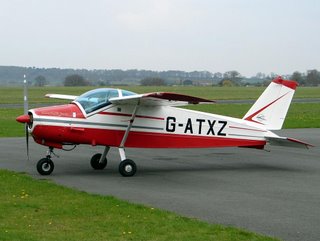
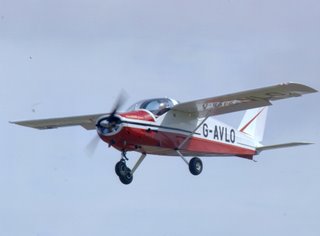
D-EGHW (209)
Owned by Tony Watson and Nick Wright, D-EGHW came to the U.K last year and is based at a private strip in Hamphire. Nick started flying the Monsun in November 2006 and has managed 10 hours since! (given the weather over this period, this is no small achievement). We look forward to hearing more about the aeroplane, and hope to see it at the next Bolkow fly-in.

D-EMUH
Owned by Marc Bonnier since July 2006, 'Uniform Hotel' is based at Voves-Viabon, a private strip near Chartres, France. Another of Gunther's Bolkows! (more info to follow)

Rotterdam to Blackpool! - Trip report
The plan was for my wife and I to fly ourselves down to Jersey for a week. She was happy to get a few days off work, and I was happy about getting some flying in. Having sold my Bolkow last October in order to fly something more reckless (and only one seat!), I needed to prise a set of Bolkow keys from my Dad for a couple of weeks. This involved getting a flight across to Rotterdam where G-BSME is based, and from where my trip would begin. Kathryn, my wife, decided not to accompany me across to Rotterdam. She is not an avid aviator, and was not really (if I'm honest) realishing the prospect of the flying part of the holiday. No real problem, West Sussex is pretty much in between Rotterdam and Jersey (close enough anyway).
Arriving in Rotterdam on the Friday, the weather was grim, and the forecast for the weekend wasn't much better. 'Hmmm, who's idea was this?' I thought as we planned, and replanned my trip back to the U.K. 'Well, it was my idea, and a good one at that! The weather will improve, it always does...eventually', I thought. A Sunday return was out of the question. High winds, low cloud, horizontal rain, the lot! However, the forecast for Monday was better.
Monday morning; The weather was good in Rotterdam, and good in the U.K. The Belgian coast looked less than ideal, but flyable. And so it proved to be. Departing Rotterdam I was able to climb to 2500ft and tracked the coast south-west towards Midden-Zeeland. So far, so good. Geographical borders (certainly in Western Europe) are largely political. Not so on this Monday morning approaching the Belgian one. Mother Nature had decided to encamp on the border itself and I was met with a wall of cloud. I decended to 1200ft to dip under the cloud. The visibility under the cloud was pretty good (certainly close to 10K), definately good enough to keep going. An updated weather check from Ostend confirmed my suspicions - a base of patchy cloud at 1200ft and 8km vis. Ostend approved a zone transit following the coast, and the ride was silky smooth. Just before the handoff to Koksijde, Ostend told me that Koksijde wanted me to climb to 2500ft to transit their zone, if not I would have to go around their zone (not good). Just as I was recalculating my route and about to key the mic, the cloud lifted!
Almost spookily, the cloud disintergrated to reveal a bright blue sky. I took the climb to 2500ft and said farewell to Ostend. Coasting out at Dunkirque to avoid the power station at Gravelines, the weather was now glorious. I climbed to 3000ft for the Channel crossing, and left the French coast at Sangatte making direct for Lydd. Ground speed at this point, due to the strong westerly wind, was atrocious. The GPS was giving 75-80kts, but the air was beautifully smooth and I was in no real rush.
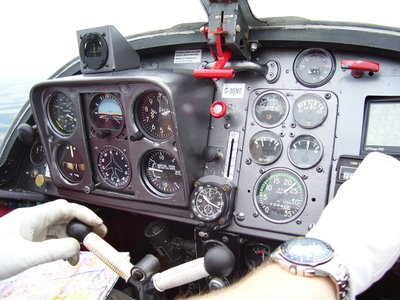
Making landfall at Lydd and tracking West to pass North abeam Deanland and Shoreham, I finally sighted home territory and began a gradual cruise descent towards Goodwood. Landing after a flying time of 2hrs 55 minutes I was ready for a cup of tea. Kathryn was waiting for me, and looking displeased. My pondering progress had meant that I was a good 30 minutes past my ETA. A bit of grovelling and shifting the blame onto my Dad for giving 'shoddy information' and all was forgiven.
So, Jersey...what happened to that then? Well, we went back to the house to check the weather. The forecast for the South-West was terrible. Bright intervals, but early morning fog was going to linger for a good part of each day. In fact, Helen Willets informed us that it would be Thursday afternoon before we might be in a position to head in that direction. We needed a Plan B!
The rest of the country appeared to be o.k, in fact better than o.k. ''Look, its nice all week up North, lets go and see your parents.'' Kathryn's parents live in Lytham, just outside of Blackpool - ideal. Now, I'd heard horror stories about flying into such airports (ones with 'Big Airport syndrome'). You can usually tell these apart as they'll have names like London Little Bibbington Regional International Business Spaceport. They're large enough to attract the one or two low-cost commercial movements per week but have a nasty habit of charging 'the Earth' for GA traffic to infringe upon their apron. These tales proved to be just that - tales. More on this later.
The route was to take us from Goodwood, north-west to Popham, then north to Oxford, Banbury and Coventry. From Nuneaton we would turn north-west again towards Stoke and Crewe, and then north between the Liverpool and Manchester CTAs. From Wigan it's north-west direct to Blackpool.
 Decending to remain below 1250ft to route through the Manchester low-level corridor, we got a good view of urban Warrington! Haydock Park racecourse and Wigan's JJB football stadium also passed under our wing. Leaving the corridor, we gave Warton Radar a call for the transit and initial approach into Blackpool. Warton will typically give you a squawk and (if routing from the South) will ask you to route via Southport Pier. We could see Blackpool's Pleasure Beach from a good distance out as we crossed the Ribble Estuary.
Decending to remain below 1250ft to route through the Manchester low-level corridor, we got a good view of urban Warrington! Haydock Park racecourse and Wigan's JJB football stadium also passed under our wing. Leaving the corridor, we gave Warton Radar a call for the transit and initial approach into Blackpool. Warton will typically give you a squawk and (if routing from the South) will ask you to route via Southport Pier. We could see Blackpool's Pleasure Beach from a good distance out as we crossed the Ribble Estuary.
We decided to uplift our return fuel there and then, rather than try to do it when we wanted to leave. Again, the fuellers were particularly helpful and did everything for us. High-vis jackets are mandatory at Blackpool, which is common sense when you consider how busy the apron is. We secured the aeroplane in the grass parking area (Fylde Park) and were let out at a security gate. We arrived on a Tuesday and left on Saturday and were charged just £27 for the landing and parking, which I consider to be very good value.


